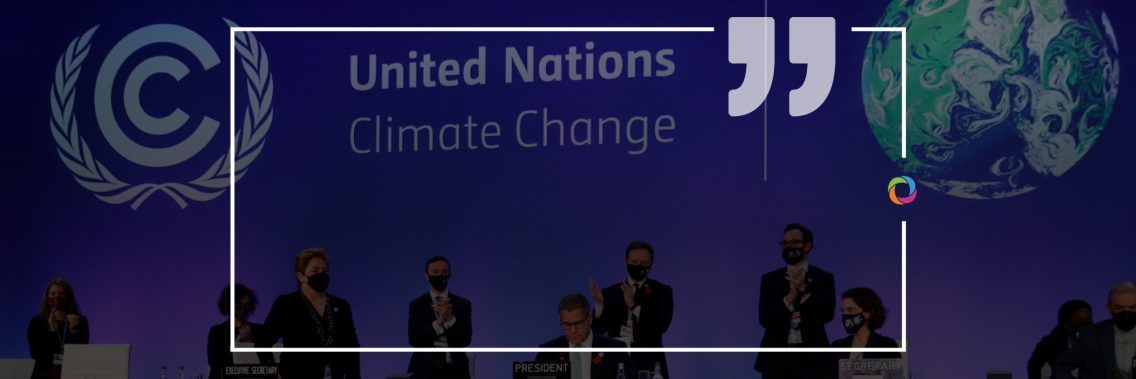In early November, over 20,000 people attended the climate talks hosted by the United Nations at the Conference of the Parties in Glasgow, Scotland. The COP26 summit brought parties together to speed up action towards the goals of the Paris Agreement and the UN Framework Convention on Climate Change. As record-breaking numbers of delegates gathered in the Scottish city, they were joined by world leaders and massive numbers of protesters on the streets. Under pressure, the participants reached an agreement aimed at maximizing the reduction of greenhouse gas emissions into the atmosphere by 2030. However, according to many experts, the proposed measures in this regard are, to put it mildly, not ambitious enough.
Key Takeaways
- The COP26 agreement mentions countries will meet next year to pledge further cuts to emissions of carbon dioxide (CO2) – a greenhouse gas which causes climate change;
- Climate change is outpacing the fossil politicians and countries are not at all on track to meet international climate goals;
- A major failure was with regard to climate finance: the 2009 pledge by developed countries to mobilize US$100 billion per year by 2020 is unlikely to be met even by 2023;
- A notable COP26 outcome is the move from a five-year in-depth ratchet to an annual hard look;
- Encouraging pledges: ensuring all sales of new cars and vans being zero-emission by 2040 or earlier and stopping and reversing deforestation by 133 countries by 2030.
Check out broader insights from the experts’ below.
What are your comments on the results of the 26th COP event?

“COP26 was moderately successful on four priorities of the UK Presidency: Coal, Cash, Cars, and Trees. It made a good start by including a phasing down of coal and subsidies for fossil fuels, although it does not specify a timeline by when this will happen. A qualified success of COP26 is the finalization of the Paris Rule Book after six years of negotiations, albeit with a few compromises (e.g., permitting some legacy credits for a limited time) on environmental integrity. A major failure is on climate finance: the 2009 pledge by developed countries to mobilize US$100 billion per year by 2020 is unlikely to be met even by 2023. While there are requests to double adaptation finance to US$40 billion per year by 2025 and initiating a dialogue to discuss the funding of a new organization for “loss and damage”, there is no clear pathway to ratchet up climate finance by 2025 or discuss climate reparations to the most vulnerable countries already impacted by climate change. There was no agreement on a levy on carbon credits to support adaptation. COP26 saw some encouraging pledges such as (i) ensuring all sales of new cars and vans being zero-emission by 2040 or earlier, and (ii) stopping and reversing deforestation by 133 countries by 2030, but progress remains to be seen as these pledges are legally non-binding.”

“In the run-up to COP26, UNFCCC papers showed eight large coastal cities, low lying small island states, and low-lying coastal regions would be underwater – some by 2030 – without drastic action. But … the US held its largest-ever auction of oil leases the week after COP and the largest carbon emitter, China significantly increased coal power emissions over the fortnight of COP. The COP President’s plea to ‘Keep 1.5 alive’ is a life preserver in a hurricane. China and the United States, the two largest emitters, issued a joint declaration on enhancing their actions. Critics looking at the summit statement say this was among the better points in an event lacking in ambition and vision and – from some perspectives – dominated by interest groups and the rich.
So, what did COP26 say in the end?
- Coal was mentioned, good
- Some countries pledged to cease financing new fossil fuels projects by 2022, good
- Non-state finance actors with US$130tn under management committed to solely promote climate-proof projects, good
- Other points included action on forests, methane, and vehicle emissions
High points for developing states? The start of collective lobbying from small island, coastal, and developing nations. Visibility for indigenous people, young climate activists, climate INGOs, alternative leaders such as ‘The Elders’? Too few and too late. COP was dominated by fossil fuel interests. To be successful, bottom-up activists and groups must develop an organized, mature, effective global voice, starting now. Previous COPs were marked by promises, not delivery. As COP26 wrapped up, climate funding for developing countries and continued reliance on coal remain to be tackled. In 2009, wealthy countries pledged US$100 billion p.a. to help low-income nations by 2020. Twelve years on, that pledge is broken. At the moment, we are just not on track. Probably the best COP outcome was the move from a five-year in-depth ratchet to an annual hard look. Egypt will host COP27 in 2022. Can developing states and climate INGOs organize properly for that? Do they have the political linkages to effectively pressure preparations? Can they prioritize what needs to change fast? Is there an alternative leadership out there? We may already be late for the 2.0 degree bus, maybe 2.4, even 2.7, never mind 1.5. For wealthy countries, the consequences are more migration, more wars, ISIS-like terror threats – costly. For developing countries, poverty and political stakes are far higher. We all have a role here.”

“As often, a COP meeting ended in an anticlimax, Glasgow was not different. The three coalprits, China, India, and Australia, managed at the last minute to water down the agreement. The glass is definitely half empty as fossil fuel-based and carbon-intense economies continue to unalter their pathway to disaster. The planet has already warmed by 1°C and climate hazards are already plaguing the planet. A planet with a pitch fever of 2°C or more is not an option. The CO2 emissions calculated by Ourworldindata show that we are still emitting heavily; above 36 billion annually. The slowdown negotiated in Glasgow will make it even more impossible to reduce global emissions by half by 2030, especially as there is a final push to dig up fossil fuels. The glass is half full because most parties committed to stopping deforestation and the linked CO2 emissions. But we also need this sun umbrella to try to keep the planet cool. Yet, we will have to wait and see whether the major forest kingdoms, Brazil and Indonesia including Papua Guinea, will live up to their pledge. The forest in DRC is relatively safe due to the dysfunctional government whereas the Amazon is at the mercy of a dysfunctional government. Am I hopeful for the next COP meeting? Not really. Climate change is outpacing the fossil politicians. Let’s hope the financial sector steps in, who must be getting tired of losing money in the trillions due to climate change.”

“COP26 produced mixed results. On the one hand, it was encouraging that the full implementation of the announced targets adds up to 1.8C warming (and maybe even less with the deals to end deforestation and cut methane emissions) which is far better than imagined a few years ago, and it was the first time fossil fuels have been mentioned in a climate change agreement. On the other hand, if you consider what path the world is on based just on the 2030 pledges, rather than long-term targets, we are on track for 2.4C warming. This could prove deadly to the world’s coral reefs and to small island states such as Barbados, the Marshall Islands, and Tuvalu. There was also the last-minute decision to change the wording of the Glasgow Climate Pact to “phase down” rather than “phase out” coal, initiated by India and China, and no money has been pledged to assist vulnerable countries with climate-related loss and damage. Despite these issues, I would say the outcome of COP26 is better than the “blah, blah, blah” rhetoric suggested by Greta Thunberg but not enough to avoid the worst impacts of climate change.”
Are countries on track to meet international climate goals? Discuss your position.

“Countries are not at all on track to meet international climate goals. Pledges now put the world on course for between 2.5C and 2.7C of warming by 2100. Even if all the pledges and commitments made at Glasgow along with the national climate action plans submitted so far are met, it would only equate to just about 25% of the effort needed by 2030. COP26 requested countries to improve their 2030 national climate targets by the end of 2022, but it is not legally binding. Given the previous scorecard of most countries, it is unrealistic to expect the new commitments to be made by December 2022 can fill the gap of the additional 75% of the required effort by 2030. If the past performance of countries in implementing pledges made at the previous such summits is any indication, one can remain considerably skeptical.”

“Right now, the simple answer is no. According to Climate Action Tracker, current policies put the world on track for 2.7C degrees warming, whereas full implementation of the climate pledges could restrict global warming to 1.8C vs pre-industrial levels. What this means is there is a clear mismatch between what has been set as a goal and what is currently being done to achieve this. Countries are also not on track to deliver their international climate finance goals, with the US$100bn climate finance target by 2020 not met thus far.”
Check out more than 500 job opportunities in the Environment & NRM sector here.

